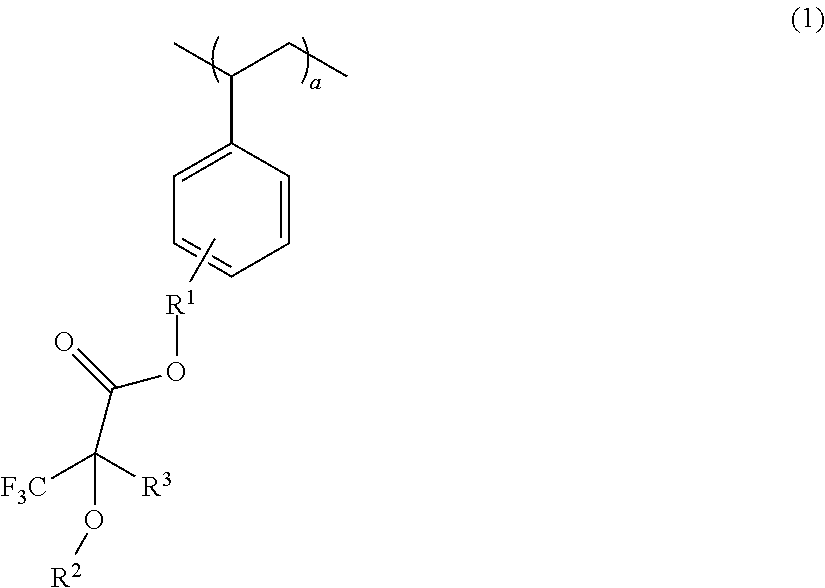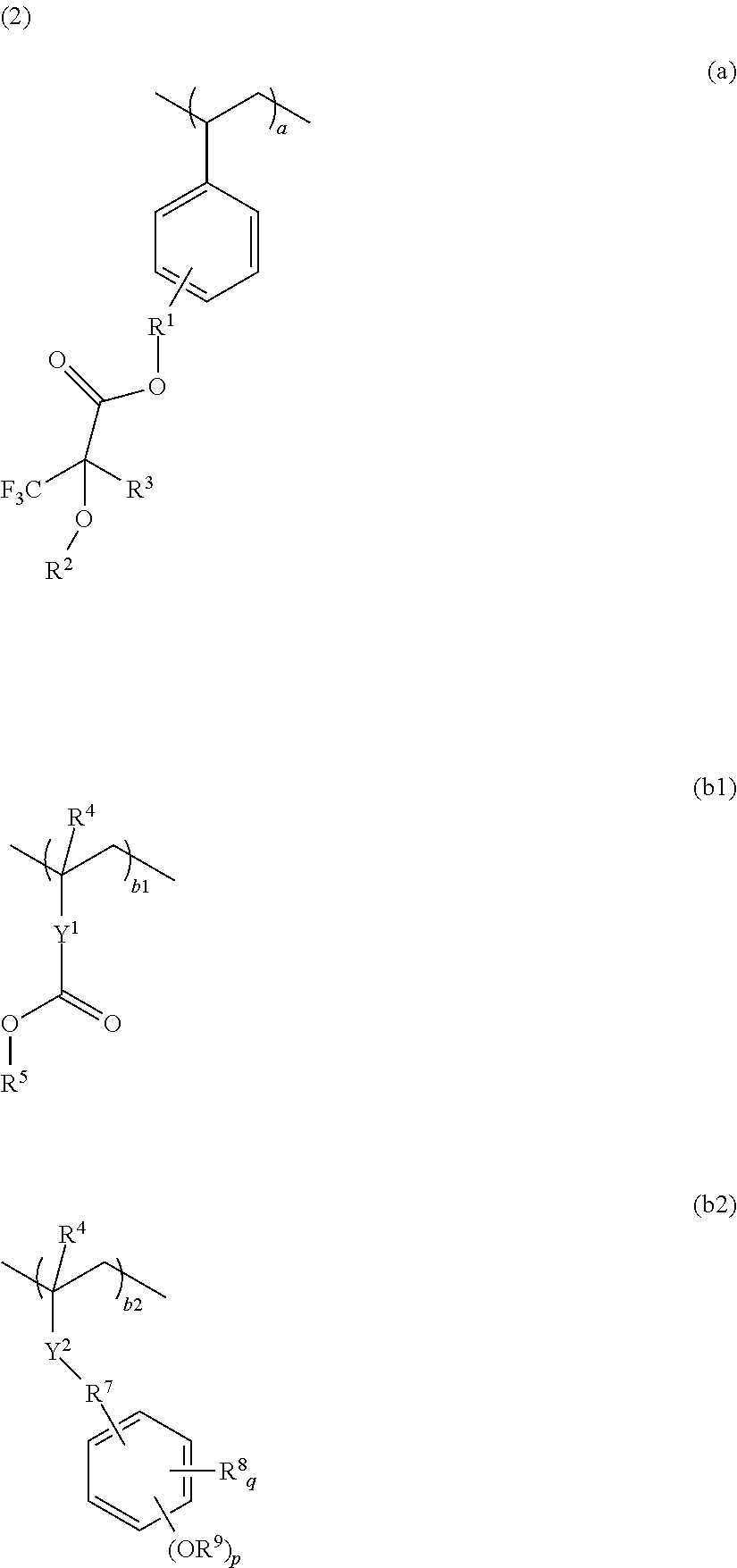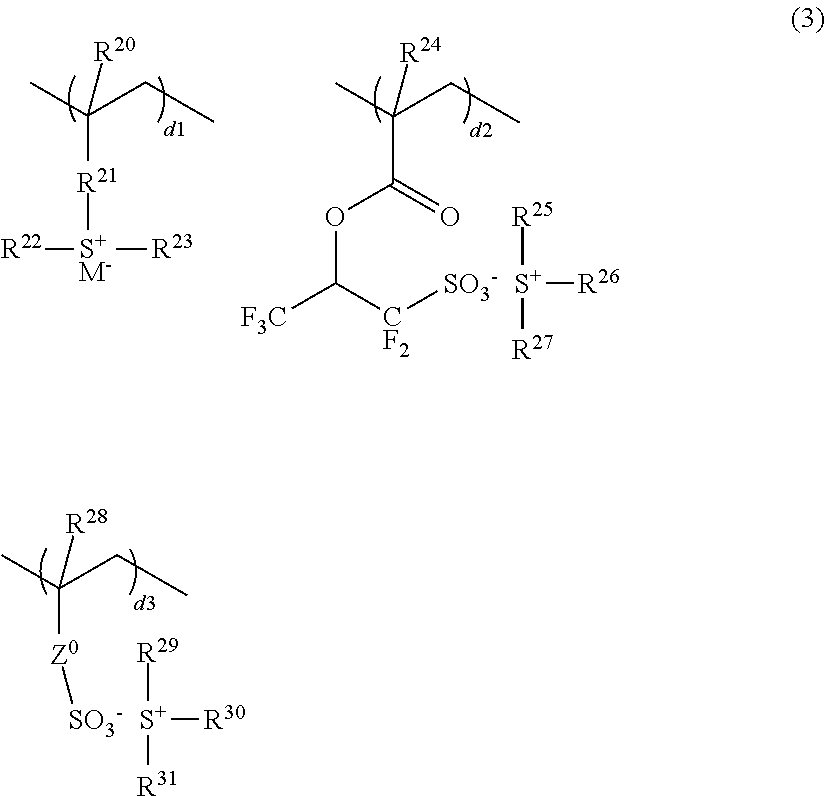Positive resist composition, monomer, polymer, and patterning process
a technology of composition and resist, applied in the field of positive resist composition, can solve the problems of unsatisfactory reduction of throughput, drastic reduction of sensitivity and contrast, image blur caused by acid diffusion, etc., and achieve the effect of suppressing acid diffusion, good profile and high resolution
- Summary
- Abstract
- Description
- Claims
- Application Information
AI Technical Summary
Benefits of technology
Problems solved by technology
Method used
Image
Examples
synthesis example 9
Monomer Synthesis Example 9
Synthesis of Monomer 9
[0148]
[0149]Monomer 9 was synthesized by the same procedure as in Monomer Synthesis Example 1 except that a mixture of m-(chloromethyl)styrene and p-(chloromethyl)styrene was used instead of p-(chloromethyl)styrene. Yield 84%.
[0150]The product obtained at the end of purification was an isomer mixture consisting of major isomer (above formula) and minor isomer in a ratio of 61 mol %:39 mol %.
[0151]boiling point: 52-53° C. / 12 Pa
[0152]IR (D-ATR): v=3463, 3093, 3013, 1757, 1632, 1515, 1455, 1378, 1321, 1262, 1238, 1223, 1162, 1017, 979, 916 cm−1
[0153]1H-NMR (600 MHz in DMSO-d6, only major isomer): δ=9.25 (1H, s), 7.48 (2H, dd), 7.37 (1H, dd), 7.28 (1H, d), 6.73 (1H, dd), 5.83 (1H, d), 5.42 (2H, s), 5.29 (1H, d) ppm
[0154]19F-NMR (565 MHz in DMSO-d6, only major isomer): δ=−73.65 (6F, s) ppm
synthesis example 10
Monomer Synthesis Example 10
Synthesis of Monomer 10
[0155]
[0156]Monomer 10 was synthesized by the same procedure as in Monomer Synthesis Example 2 except that Monomer 9 was used instead of Monomer 1. Yield 90%.
[0157]Adhesive Monomers 1 and 2, and PAG Monomers 1 to 5 used in the following Synthesis Examples are identified below.
[0158]Adhesive Monomer 1: (2-oxo-1,3-benzoxathiol-5-yl) methacrylate[0159]Adhesive Monomer 2: (2-oxo-2,3-dihydrobenzoxazol-5-yl) methacrylate
[0160]PAG Monomer 1: triphenylsulfonium 1,1,3,3,3-pentafluoro-2-methacryloyloxypropane-1-sulfonate[0161]PAG Monomer 2: 5-phenyldibenzothiophenium 1,1,3,3,3-pentafluoro-2-(methacryloyloxy)propane-1-sulfonate[0162]PAG Monomer 3: 10-phenylphenoxathiinium 1,1,3,3,3-pentafluoro-2-(methacryloyloxy)propane-1-sulfonate[0163]PAG Monomer 4: 5-phenyldibenzothiophenium 1,1,3,3,3-pentafluoro-2-(3-methacryloyloxy-adamantane-1-carbonyloxy)propane-1-sulfonate[0164]PAG Monomer 5: 10-phenylphenoxathiinium 1,1,3,3,3-pentafluoro-2-(3-methacry...
synthesis example 1
[0165]A 2-L flask was charged with 13.4 g of Monomer 4, 16.4 g of Monomer 1, 3.0 g of acenaphthylene, and 40 g of tetrahydrofuran as solvent. The reactor was cooled to −70° C. in a nitrogen atmosphere, whereupon vacuum evacuation and nitrogen blow were repeated three times. The reactor warmed up to room temperature whereupon 1.2 g of azobisisobutyronitrile (AIBN) was added as a polymerization initiator. The reactor was heated at 60° C. and reaction run for 15 hours. The reaction solution was precipitated from 1 L of isopropyl alcohol. The white solid was collected by filtration and dried in vacuum at 60° C., yielding a white polymer.
[0166]The polymer was analyzed by 13C-NMR, 1H-NMR, and GPC, with the analytical data shown below.
Copolymer Composition (Molar Ratio)
[0167]Monomer 4: Monomer 1: acenaphthylene=0.30:0.50:0.20
Mw=6,800
Mw / Mn=1.88
[0168]This is designated Polymer 1.
PUM
| Property | Measurement | Unit |
|---|---|---|
| wavelength | aaaaa | aaaaa |
| size | aaaaa | aaaaa |
| boiling point | aaaaa | aaaaa |
Abstract
Description
Claims
Application Information
 Login to View More
Login to View More - R&D
- Intellectual Property
- Life Sciences
- Materials
- Tech Scout
- Unparalleled Data Quality
- Higher Quality Content
- 60% Fewer Hallucinations
Browse by: Latest US Patents, China's latest patents, Technical Efficacy Thesaurus, Application Domain, Technology Topic, Popular Technical Reports.
© 2025 PatSnap. All rights reserved.Legal|Privacy policy|Modern Slavery Act Transparency Statement|Sitemap|About US| Contact US: help@patsnap.com



